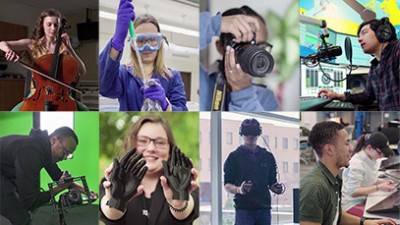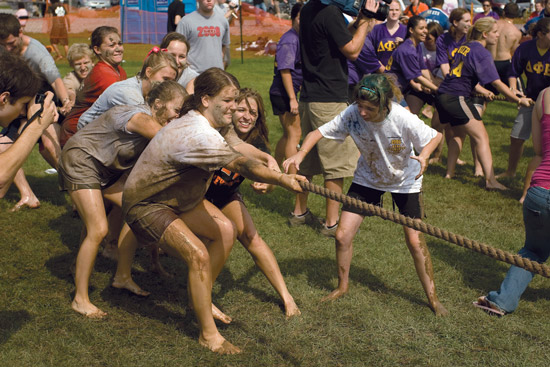Pulling for women
RIT strengthens efforts to improve gender balance on campus
Charles Neumann
Students compete in the 2008 ‘Mud Tug’ Greek event, which raised money for the national Breast Cancer Education and Awareness organization.
Basketball brought Emily Hughes to RIT.
The third-year international business and marketing student wasn’t initially attracted to the place.
“The aesthetics,” she says, were a turn-off. Too many bricks, too stark, not enough color. But the 6-foot-3-inch basketball player from Fayetteville, N.Y., “felt wanted” and is glad she decided to give RIT a try. Besides athletics, she’s been active in campus organizations including Student Government.
“Once I learned how amazing this place is, I fell in love with it,” says Hughes.
Mary-Beth Cooper, vice president for Student Affairs, isn’t surprised to hear Hughes’ assessment of RIT’s curb appeal. More can be done, although RIT has invested more than $350 million in campus improvements since 2000, including construction of the Gordon Field House and Activities Center, new apartment complexes and several new academic buildings as well as residence hall renovations and beautification projects.
“We’ve done a lot with the physical plant in the past few years, but we still need some softening, we need some color,” she agrees.
However, she and other university leaders know it will take more than decor to increase the percentage of women to 40 percent of first-year students by fall 2012 – a goal articulated by the RIT Commission on Women and endorsed by President Bill Destler. In the U.S., slightly more than half of students entering college this fall were women.
“We’ve been consistently at 30-32 percent women for more than 25 years,” Cooper says. “We’re working to move that number.”
A century ago, when RIT was known as Rochester Athenaeum and Mechanics Institute, women students outnumbered men.
“There were women enrolled in Mechanics Institute’s very first class – mechanical drawing – in 1885,” says RIT Archivist Becky Simmons.
In fact, the university’s history is studded with milestones for women.
- Rochester businessman Henry Lomb, one of the founders and first president of Mechanics Institute, championed practical education for women. Recognizing that many needed paid employment to support themselves and their families, Lomb believed women should have access to training in marketable skills.
- In 1892, Betsy Andrews, the wife of Trustee Ezra Andrews, helped found the school’s Domestic Science Department. Initially offering instruction in cooking, sewing and home nursing, the department attracted 120 students during its first term.
- Mrs. Andrews became the first woman trustee in 1893.
- By the close of the 19th century, the two-year domestic science programs included chemistry, physics, physiology and hygiene – courses that eventually became the foundation of the College of Science.
- During World War II, women students were recruited for programs including machine shop, drafting, inspection and management Women with such skills were needed “to man the victory machines of industry,” an RIT poster proclaimed.
- Edwina Hogadone, named first dean of RIT’s College of Business in 1960, was also the first woman to serve as dean of any business school in the nation.
- In 1998, the Kate Gleason College of Engineering became the first engineering school in the country named for a woman. Kate Gleason (1865-1933), an engineering and business pioneer, was a member of a Rochester family that has been associated with RIT since the late 1800s.
Tiffani Williams, a student ambassador for RIT’s Office of Undergraduate Admissions, is among the first people to welcome families during their initial visit to campus. The conversation often turns to the male-female ratio.
“Usually I tell them that it really isn’t as noticeable as you would think,” says the fourth-year graphic media major. “Also, the ratio at RIT reflects the ratio in most technical industries, so working alongside mostly males is simply a taste of what's to come. And sometimes I jokingly mention that even though the numbers sound overwhelming, think of the great odds!”
All kidding aside, Williams believes that RIT is an increasingly great place for female students.
“RIT gives us a chance to excel in some traditionally male-dominated fields,” she says. “It also encourages and nurtures our interest in technology rather than attempting to steer us in other directions. There’s a multitude of outlets and support for us on campus, and there always seems to be a lot of strong female figures to look to for models of success.”
RIT is making deliberate efforts to ensure that Williams’ upbeat viewpoint becomes the standard perception.
In 2004, former president Albert Simone formed the President’s Advisory Committee on the Status of Women to look into issues related to recruitment and retention. Last year, President Bill Destler continued the group under a new name, the RIT Commission on Women. In July, the group presented two pages of recommendations centered on two areas: institutional transformation and curricular-related initiatives.
The commission recommends consideration of new academic options and programs aimed at increasing the numbers of women students. In addition, the recommendations call for creation of a university-based exploration/general studies program that guarantees transition into degree programs. For example, biomedical engineering has been suggested, and a program in journalism is underway.
“We know from PSAT data that a staggering number of high school juniors – men and women – don’t know what they want to do,” says Vice President Cooper. “We need to provide more opportunities for students to explore.”
Recommendations related to “institutional transformation” include recruiting and supporting excellent female faculty; encouraging gender diversity in special events such as guest lectures as well as in student organizations and publications; recognizing people who champion gender diversity; and fostering traditions for women.
“We need to be very intentional about having women represented in what we do,” says Cooper. “We have to be very conscious about our efforts. If we stop moving, we lose ground.”
As for traditions, RIT’s Women’s Center has created several events recognizing women. Lighting the Way, which takes place during orientation week, is an annual ceremony begun in 2006 in which the light of knowledge is symbolically passed on to first-year women.
The annual spring Women’s Career Achievement Dinner, sponsored by the Women’s Center, RIT Leadership Institute, and the Alumni Relations Office, honors invited alumnae from RIT’s eight colleges and women students at RIT.
“RIT is really recognizing that we want more women here,” says Donna Rubin, director of the Women’s Center. “It’s wonderful to see the response.”
The Women’s Center opened in 1999, but dating to the mid-1980s or earlier, there were women faculty and staff who got together to network and advocate on behalf of women.
“The culture was waking up,” says Rubin. “Women’s studies programs began popping up on college campuses in the 1970s in response to the women’s movement. At RIT, with the high percentage of men, it took a little longer.”
Today, the Women’s Center provides services such as Campus Advocacy Response and Support (CARES), an anti-violence program, and Gender Communication and Respect, which is presented as part of the First Year Experience program.
“We’re not implying that all women need support,” says Rubin. “But we’re here for anyone who needs us – men or women.
“We want to help people develop interpersonal skills and have a good understanding of civility and respect. When you make an environment that benefits women, it benefits everyone.”
In fact, most women students at RIT don’t seek out help in dealing with gender issues. Cooper says that the majority of RIT’s women students – even those in programs where they are vastly outnumbered – cope extremely well.
Melissa Muscato ’98 (civil engineering technology) was the only woman student in most of her classes. Even so, Muscato, who came to RIT after graduating from Alfred (N.Y.) State College of Technology, found the atmosphere supportive, even nurturing. Department chair Robert Easton (now retired) and staff assistant Marilyn Bullard were helpful and friendly, she says, and “Professor Maureen Valentine was a wonderful role model.”
“I never wanted to be treated differently, to be thought of as a minority or play ‘the sex card,’ ” Muscato says. I was a member of SWE (Society of Women Engineers), but I didn’t feel I needed a support group and I don’t highlight that on my resume. Companies don’t want you focusing on that.”
After graduation, Muscato went to work for the international engineering, architecture and construction firm Whitney, Bailey, Cox and Magnani out of Towson, Md., later transferring to the company’s Atlanta office. She’s now an engineer with Clark Patterson Lee in Charlotte, N.C.
“Real life is no different than the college experience – this is a male-dominated field,” she says. “Out in the field, some contractors don’t like being given direction by a young, female engineer. That’s where it gets difficult.
“One thing I learned from Professor Valentine is confidence. If you know your stuff, you can handle any situation.”
When Stephanie Walter came to NTID’s summer Explore Your Future program, it was the first time she had been in the company of many deaf and hard-of-hearing people.
“At home, I was always the only one,” says the fourth year industrial and systems engineering major from Lake Charles, La. “After that camp, I decided this is the place I wanted to go. I absolutely loved it.”
Being hard of hearing and a woman have posed no particular obstacles: Walter has been a resident assistant (RA) and an orientation assistant and has a student job in the Center for Religious Life. She is a member of the student chapters of the Society of Women Engineers and the Institute for Industrial Engineers and plays intramural volleyball. She’s completed two of three co-ops.
Sure, there are times when male students can be irksome. But, she says, “The guys don’t bug me. After freshman year, you get used to what they do.”
She adds, “I’ve made good friends, and friends really help you through.”
RIT fosters a sense of community, Britta MacIntosh ’89 (mechanical engineering) believes.
“Learning to be an engineer is very challenging, but I always felt I had a strong support structure around me,” says MacIntosh, a native of Upper Marlboro, Md., who is now vice president of business development for NORESCO LLC, a major international energy services company, in Westborough, Mass.
Although there was one faculty member – no longer at RIT – who openly expressed his opinion that women should not be engineers, MacIntosh wasn’t deterred: “I felt the school was trying to make women feel welcome. I certainly didn’t feel lonely or intimidated, and I never felt excluded from any opportunity based on gender.”
Her background no doubt helped: MacIntosh attended a science and technology high school and she was a volunteer fire fighter before and during her time at RIT.
On recent visits to RIT (MacIntosh was named Kate Gleason College of Engineering Distinguished Alumna this year and spoke at the college’s commencement ceremony in May), she has noticed some changes that make RIT more appealing to women. For instance, there are many more gathering spaces for students, and “women like to work in groups.”
Subtle changes are adding up to a noticeable difference.
“I’m excited to see so many more women.”














